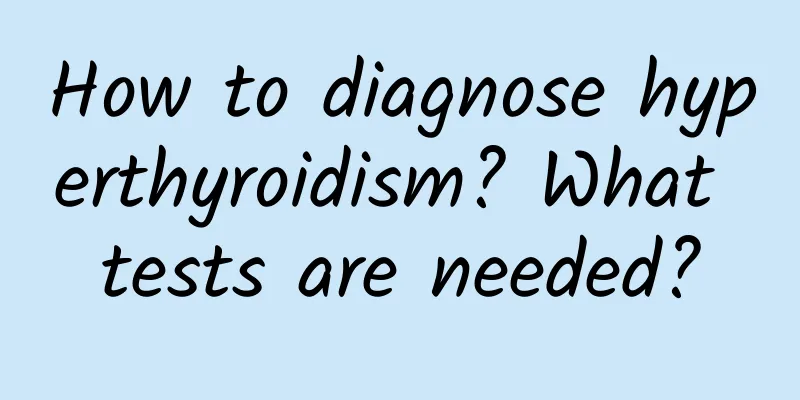How to diagnose hyperthyroidism? What tests are needed?

|
There are many patients with hyperthyroidism. The causes of this disease are very complicated and there are many symptoms. Some symptoms are easily confused with other diseases. These symptoms need to be carefully diagnosed to avoid misdiagnosis and adverse consequences. So what are the diagnostic methods for hyperthyroidism? How to diagnose hyperthyroidism Diagnosis of hyperthyroidism 1. Measure the level of pituitary thyroid-stimulating hormone (TSH) to understand the nature of hyperthyroidism. Diagnosis of hyperthyroidism 2. Antibody (TGAB, etc.) testing to understand the cause of hyperthyroidism and the immune disorder status. Diagnosis of hyperthyroidism 3. Thyroid hormone level measurement (FT3 and FT4 on the test report) to determine the synthesis and secretion function of thyroid hormone. The above are the diagnostic methods and key points of hyperthyroidism. For patients with unclear symptoms, further examination is required. For example, for patients with malignant exophthalmos, eye CT or MRI examination is required to understand the situation behind the eyeball. B-ultrasound examination can understand the thyroid gland morphology and blood flow status. For special situations, attention should be paid to the diagnostic points to avoid misdiagnosis. What are the other diagnostic methods and key points for hyperthyroidism? Even or uneven distribution of thyroid scans may appear as "cold nodules". During pathological examination, if there are no typical manifestations of hyperthyroidism and the antibody titer is low or negative, fine needle aspiration cytology or tissue biopsy can be used to confirm the diagnosis. Middle-aged women with diffusely enlarged and hard thyroid glands should be considered to have hyperthyroidism regardless of whether their thyroid function is normal. Serum TGA and TMA titers are significantly elevated, which can basically confirm the diagnosis. For elderly patients with hyperthyroidism, the symptoms are often similar to those of other diseases. Especially when they experience depression or gastrointestinal diseases, the possibility of hyperthyroidism should not be ignored. The above are some methods for diagnosing hyperthyroidism. If you find symptoms of hyperthyroidism, you must refer to the above diagnostic methods to confirm the disease. After confirmation, hyperthyroidism can be treated well according to the corresponding treatment methods. However, if the diagnosis is not taken seriously, it may lead to confusion with other diseases, which will affect the treatment of the disease. |
<<: How to remove pubic hair? What are some quick ways to remove pubic hair?
>>: What are the sequelae of depression in men?
Recommend
What is the reason for the white dirt on the glans?
If men find white dirt on the glans, they must pa...
Why do you ejaculate every day? Andrology experts tell you the answer
In most cases, it is normal for men to have sperm...
Men should pay attention to 4 points when sleeping naked, there are 4 great benefits
Sleeping naked is a favorite of men. In addition ...
What is the reason why fat people have poor sexual function?
As modern society becomes more and more developed...
What medicine should men take for low libido
Low male sexual desire is a common phenomenon in ...
Male pregnancy-associated syndrome
Some pregnant women experience vomiting, sleepine...
Squid ribs soup, two ways to make it more delicious
Squid rib soup is a common delicacy in life. It h...
How to get sperm out for pregnancy test
For couples who want to have a healthy baby, do y...
What are the reasons for the penis to grow crooked?
For a man, if his penis grows crooked, he will be...
Why can't I get an erection after drinking?
In life, many men have such a hobby, that is, the...
No feeling during ejaculation
When a man ejaculates, it means he has reached or...
What medicine should men use for anal dampness
Anal dampness is a very common disease in clinica...
Why do pimples appear on the foreskin?
Men should certainly pay attention to the health ...
What are the ways to enhance male sexual ability?
Many male friends are busy with work all day long...
What's inside the testicles?
We may know some organs in the human body very we...









